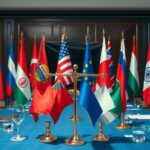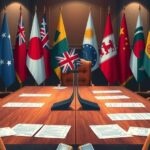Assistant U.S. Trade Representative to Engage in Tariff Talks in India
Assistant U.S. Trade Representative Brendan Lynch will meet with Indian officials in New Delhi to discuss tariffs and finalize a framework for a bilateral trade agreement. The discussions aim to align trade aspirations between the U.S. and India, with a focus on boosting economic ties and mitigating trade imbalances, particularly regarding China. The negotiations are a step towards increasing bilateral trade significantly by 2030.
Assistant U.S. Trade Representative Brendan Lynch is set to arrive in New Delhi today for discussions centered around tariffs, reflecting Washington’s commitment to fostering productive trade relations with India. The U.S. delegation will engage with Indian counterparts to finalize a framework for a bilateral trade agreement (BTA) and outline terms of reference and schedules for negotiations, just ahead of President Donald Trump’s April 2 deadline for imposing reciprocal tariffs.
Meetings will occur over three days, from March 27 to March 29, aiming to align the aspirations of both nations for achieving tangible progress in the coming six months. President Trump has previously labeled India as a “tariff king,” indicating the urgency and sensitivity surrounding the trade dialogue, while the Indian external affairs Ministry noted that discussions aim to create frameworks addressing trade levies and market access.
The U.S. embassy spokesperson emphasized that this visit underscores the commitment of the United States to advance equitable and balanced trade ties with India, while officials from India echoed their intent to enhance prosperity and innovation through strengthened trade relations. They expressed optimism for constructive discussions that would mutually benefit both economies.
India’s stance involves careful consideration of the Most-Favored-Nation (MFN) tariff implications amid discussions, highlighting that any reduction might inadvertently favor China over the U.S., given the existing trade laws. As per reports, leaders Modi and Trump previously agreed to negotiate a comprehensive trade deal aimed at more than doubling bilateral trade to $500 billion by 2030, mitigating tariffs for mutual gain.
Negotiations face the challenge of complying with World Trade Organization (WTO) rules, particularly concerning non-discrimination in trade. The proposed trade agreement may not be classified as a Free Trade Agreement (FTA) at this point, but both nations recognize the necessity of establishing legal frameworks to circumvent the MFN constraints, primarily to prevent an influx of Chinese goods into the Indian market.
The upcoming discussions in New Delhi led by Assistant U.S. Trade Representative Brendan Lynch highlight the intricate and strategic negotiations between the United States and India aimed at creating a balanced trade framework. Both nations seek to address tariff issues and enhance their economic ties, with a mutual goal of doubling bilateral trade by 2030. These talks are critical in shaping the future of trade relations, especially amidst ongoing international pressures and trade dynamics.
Original Source: www.hindustantimes.com








Post Comment